Colombia Travel Guide
Colombia is undoubtedly one of the hottest destinations of the moment. Associated for years with guerrillas and drug trafficking, it has made such strides in security that Lonely Planet named it the second-best country to visit in 2017.
I spent six weeks travelling low-cost backpacking in Colombia, and here you will find my guide to visiting on a budget, but it can certainly come in handy for those who “don’t mind the expense.”
Quick menu
- When to visit Colombia
- Documents and vaccinations to enter Colombia
- What to do and see in Colombia
- Suggested itineraries in Colombia
- How to get around Colombia
- Backpacking Colombia: costs
- Backpacking Colombia: safety and security
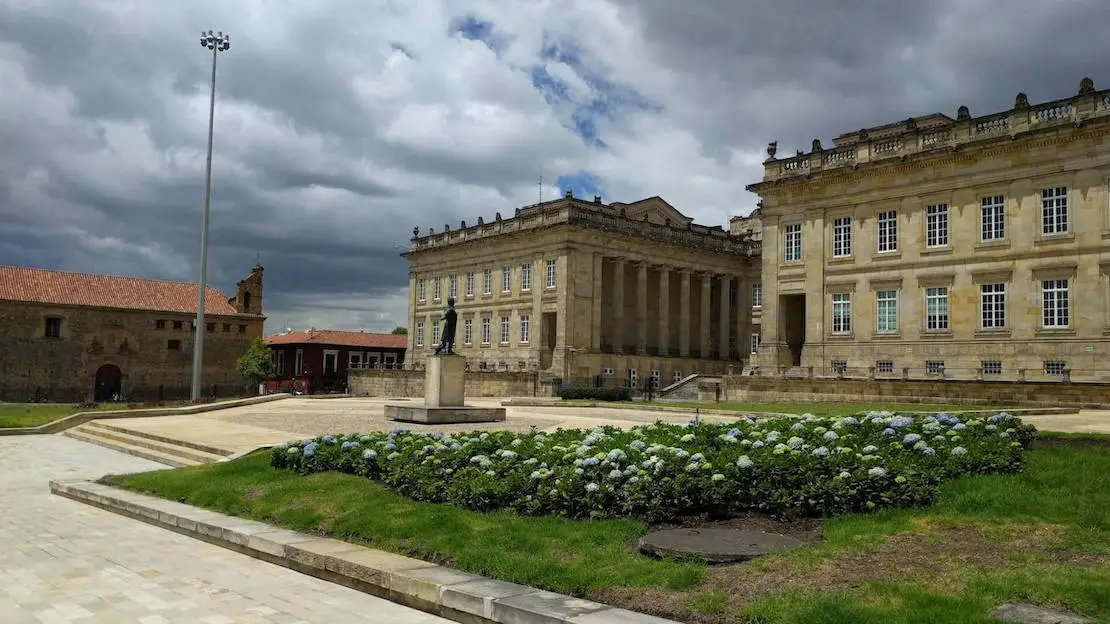
Colombian parliament, Bogotá.
When to visit Colombia
The proximity to the equator means that temperatures remain constant throughout the year and vary mainly with altitude. What differs significantly with the time of year is rainfall; in fact, there are two seasons:
- The dry season, December-January and July-August, is commonly called summer.
- The rainy season, April-May and October-November, is usually called winter.
The Amazon rainforest covers about a third of Colombia, and here, unfortunately, the climate is humid throughout the year.
It is good to remember that the tourist season, with the highest prices, is from December to February. Although this period coincides with the best weather, it is good to remember that even during the rainy season, the rainfall is stormy and never lasts long, which makes it an excellent year-round destination.
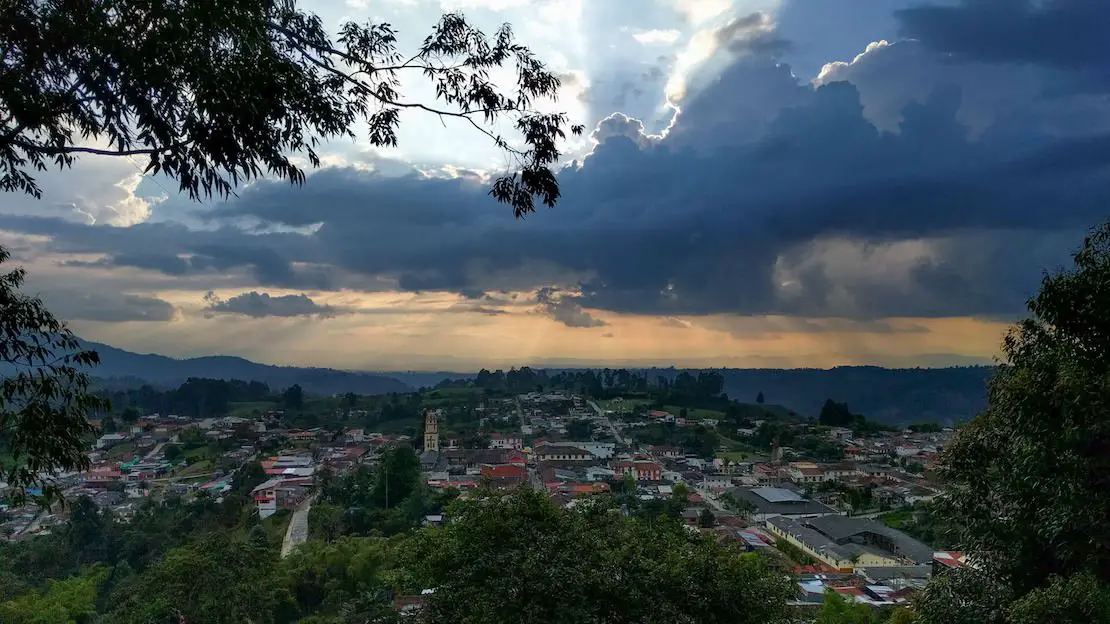
Mirador alto de la cruz, Salento.
Documents and vaccinations to enter Colombia
Most nationalities receive a 90-day tourist visa when they enter the country. It is possible to renew the visa by leaving the country and re-entering on the same day as long as you do not exceed 183 days per calendar year.
I have not personally had experience with this, but reading here and there; it would seem that the 183 days per calendar year is not always applied and depends a lot on the border officer.
For more information, please visit the official website.
Colombia does not require any mandatory vaccinations, but Hepatitis A, Hepatitis B and yellow fever are recommended, the latter especially if you decide to visit the Amazon rainforest.
What to do and see in Colombia
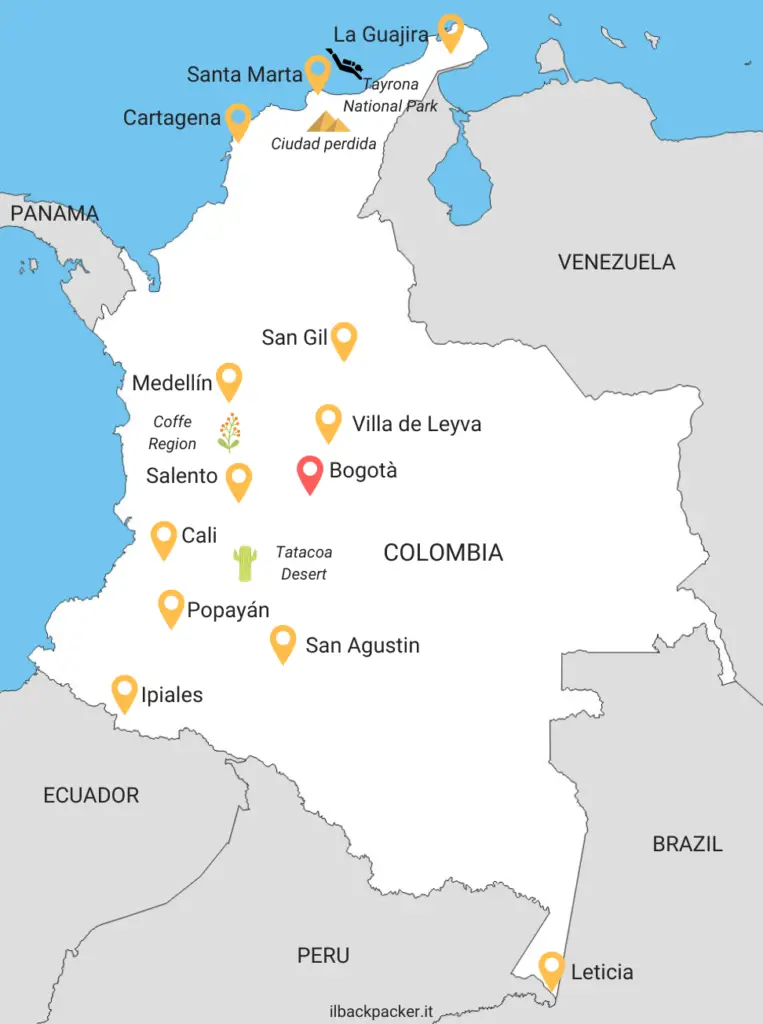
As you can see from the map, most tourist destinations and major cities are clustered in the west and north of the country, while the Amazon rainforest covers the southeast.
Bogotá
Bogotá is 2664 meters above sea level, so you may need to acclimatise. As soon as you arrive, even climbing the stairs might leave you short of breath.
What to do and see in Bogotá
In all likelihood, this will be your first stop; although the capital is snubbed by many travellers, in truth, it has much to offer.
La Candelaria
La Candelaria (Google Maps) is where most of the hostels are located; it is one of the oldest neighbourhoods in the city and can be compared to European old town centres. The area is full of colonial buildings, street performers, graffiti and typical narrow streets; here, you can also visit Plaza Bolivar (Google Maps), overlooked by the cathedral and government buildings. However, it is not among the safest areas at night; I still recommend it for its atmosphere and location. You could also take the Free walking tour Bogota or the Graffiti tour. Both tours are free, but a tip is almost mandatory, especially if you stay until the end.

Bogotà streets.
Monserrate
Monserrate (Google Maps) is a mountain with a church at the top overlooking the city from its 3152 meters. It is easily reached by cable car, and once you get to the top, you can enjoy incredible views of this endless city.
How to reach Monserrate?
It can go up by cable car; the cost is 20000 COP round trip from Monday – Saturday and 11000 on Sunday. Alternatively, you can go up on foot (about 1 hour, 400 meters elevation gain); the trail is open every day except Tuesdays from 5:00 am to 1:00 pm to go up and until 4:00 pm to go down.
Gold Museum
Gold Museum (Google Maps) receives about 500,000 tourists annually and contains the world’s most extensive collection of gold artefacts. Two other noteworthy museums are the Museo Nacional (Google Maps) and the Botero Museum (Google Maps). Cost 3000 COP, free on Sundays.

View from Monserrate.
Catedral de sal
This cathedral (Google Maps), carved out of a former salt mine, is the largest in the world and can be easily visited in one day from Bogota either by public transportation (which I recommend) or by organised tour.
How to get to the Salt Cathedral from Bogota?
If you’re staying near Candelaria, head to the Transmilenio Las Aguas station (Calle 19 and Carrera 3), buy a ticket (1700 COP) and get on the B74 bus to the last stop, Portal Norte (about 45 minutes), go to the “Intermunicipal” platform and take the bus to Zipaquira (45 minutes about 4100 COP), I was yelled “catedral de Sal” once I got to the right stop. Still, it might be better to ask in advance! From the stop, you have to walk about 2km, alternatively, take a cab. Admission to the cathedral costs 55000 COP and includes a guided tour.
Finally, a reader recommended that I visit the Santuario Virgen de Guadalupe (Google Maps), where there is a beautiful view of the city. It is much less touristy than Monserrate; you cannot go up there on foot, only by motor taxi, and exclusively on Sundays. The locals advised me against going up there alone during the week.
Where to sleep in Bogota?
Granada Hostel, located in the heart of Candelaria, is an excellent hostel at a reasonable price.
The coffee region in Colombia
The coffee region of Colombia (Eje Cafetero) is a rural area of Colombia where the vast majority of Colombian coffee, considered by many to be the best coffee in the world, is produced. Of all the possible destinations within this region, Salento is undoubtedly the most famous, while Finland is a good, less touristy alternative.
How to reach the coffee region?
To reach both countries, it is necessary to pass through Armenia, the region’s capital and public transportation hub; mini-buses leave from there for both Filandia and Salento.
Bogota -> Armenia 60000 COP and 6-8 hours
Armenia -> Philandia 4800 COP and 45 minutes approx.
Armenia -> Salento 4800 COP and 45 minutes approx.

Coffee tour in Filandia.
What to do and see in Salento
As mentioned earlier, Salento is probably the most tourist destination in the “coffee region.” Here, in addition to visiting one of the many fincas (farms) that produce coffee and participating in one of the many coffee tours where the entire production process from harvesting to tasting is shown, it is possible to visit the Cocora Valley (part of Los Nevados National Park), where you can see the Vax Palms that can reach 60 meters in height making them the tallest palms in the world.
The valley is easily reached by jeeps that depart regularly from Salento’s main square (Google Maps) and take about half an hour to reach their destination.
Once you arrive, you can take a 4-5 hour circuit (All Trails) that winds along the valley or take a short walk to admire the palm trees exclusively. If you decide to do the entire circuit, I recommend stopping at the Hummingbird Sanctuary (They now charge 20000 COP which is a little too much..) To return to the village, hop in one of the jeeps that frequently return once filled.
Finally, close to the town center there is a nice viewpoint called Mirador Alto de la Cruz (Google Maps).
How do you reach the Cocora Valley from Salento?
Jeeps leave at the following times: 6:10 a.m., 7:30 a.m., 9:30 a.m. and 11:30 a.m. from the square for 4500 COP, about half an hour. The entrance to access the valley is 20000 COP.
Where to sleep in Salento?
I recommend staying at Km0 Hostel.

Cocora Valley.
What to do and see in Filandia
Filandia is an alternative destination for those who want to avoid the much more popular Salento. Filled with brightly coloured colonial buildings and very few tourists roaming the streets, it has nothing to envy its more famous sister.
Here, you can visit one of the many coffee fincas, explore the town’s breathtaking scenery on foot or by bike, or spend the day sipping delicious coffee.
Where to sleep in Filandia?
Bidea Backpackers Hostel is one of the best hostels I have ever stayed in. The staff is friendly and helpful, breakfast is included, and coffee is free all day. Bikes and a movie theatre are available to get around the area, all at a great price. I can’t recommend it enough!
Medellin
Medellin is Colombia’s second-largest city in terms of population. Although infamous for its history of violence related mainly to drug trafficking, the city has made considerable strides in recent years, so much so that it was recently voted the world’s most innovative city, ahead of New York and Tel Aviv.
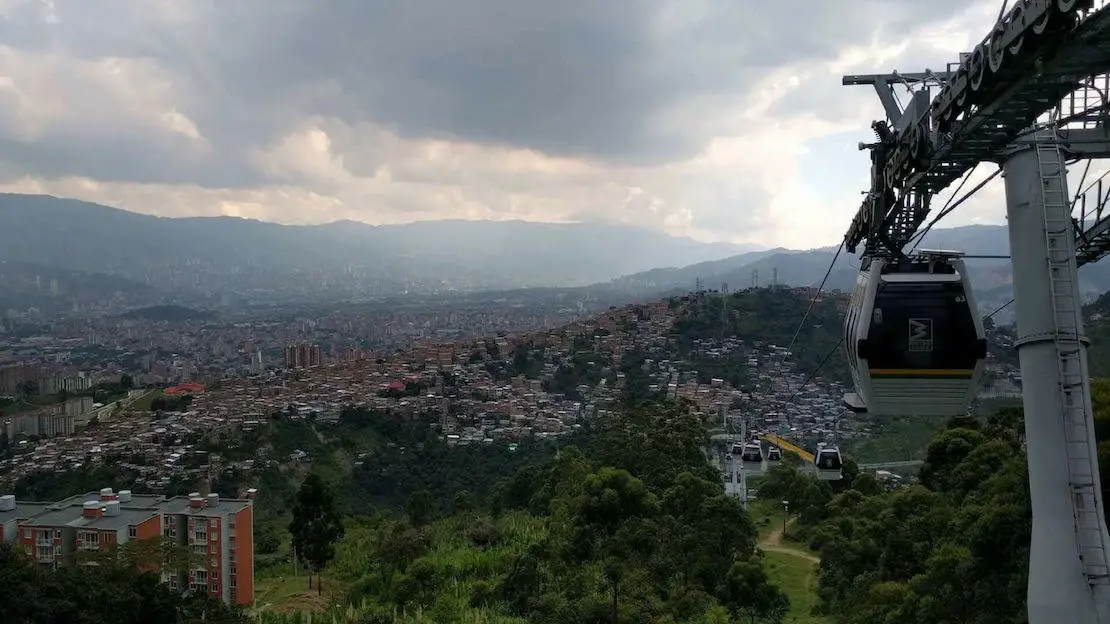
The cable car that takes you to Parque Arvi, Medellin.
What to do and see in Medellin
I recommend joining the free walking tour (probably the best one I have ever participated in). By joining the tour, you will have an extremely knowledgeable guide on the city’s history and an easier time getting to know other people (which is helpful if you travel alone). The points of interest touched by the tour are the old train station (Google Maps), Alpujarra the city’s administrative center (Google Maps), the Plaza of Lights (Google Maps), the National Palace Mall (Google Maps), the Veracruz Church (Google Maps), Botero Square (Google Maps), Bolivar (Google Maps), San Antonio (Google Maps), and Berrio (Google Maps) parks.
I recommend visiting the Minorista market (Google Maps) and Parque Lleras (Google Maps) at night (the park is in the centre of Medellin’s nightlife, surrounded by bars and clubs). Two other pleasant and extremely inexpensive activities are to reach Parque Arvi (Google Maps) by Cable Car (it is directly connected to the metro and is part of the public transportation system in its own right), visit the escalators of Comuna 13 (Google Maps), the botanical garden (be sure to get inside the giant “cage” where the butterflies are) (Google Maps). For lovers of science, nature, and technology, I strongly recommend Parque Explora (Google Maps), which is located not far away (an interactive museum).
In conclusion, don’t think twice if you can go to a soccer game at the stadium. Avoid going to the corner alone and taking valuables; otherwise, you should be comfortable and enjoy a warm atmosphere.
A blog reader also told me that admission to the Medellin planetarium (Google Maps) costs 11000 pesos and is worth it if you are an astronomy lover.
Guatape
Guatape (Google Maps) is located a short distance from Medellin (2 hours by bus) and is easily accessible by public transportation, great for a day trip. Famous for its brightly coloured historic buildings, it is a lovely little town to visit, but the natural attraction is the Piedra del Penol (Google Maps). Indigenous tribes once revered this rather curious monolith, and it is easy to see why. You can now climb the stairs to the top, enjoying a beautiful view of the lake below.
How do you go from Medellin to Guatape?
Buses leave from the Medellin bus terminal every hour for 12500 COP. Piedra de Penol entry is 20000 COP.
Where to sleep in Medellin?
I stayed in Medellin for three weeks and can recommend as many as four hostels. Arcadia Hostel is where I spend most of my time, just outside El Poblado (the safest and chicest area of the city). It is a good hostel, cheap and clean, and a cake and breakfast are included. Casa Kiwi Hostel is well located and laid out but not cheap.
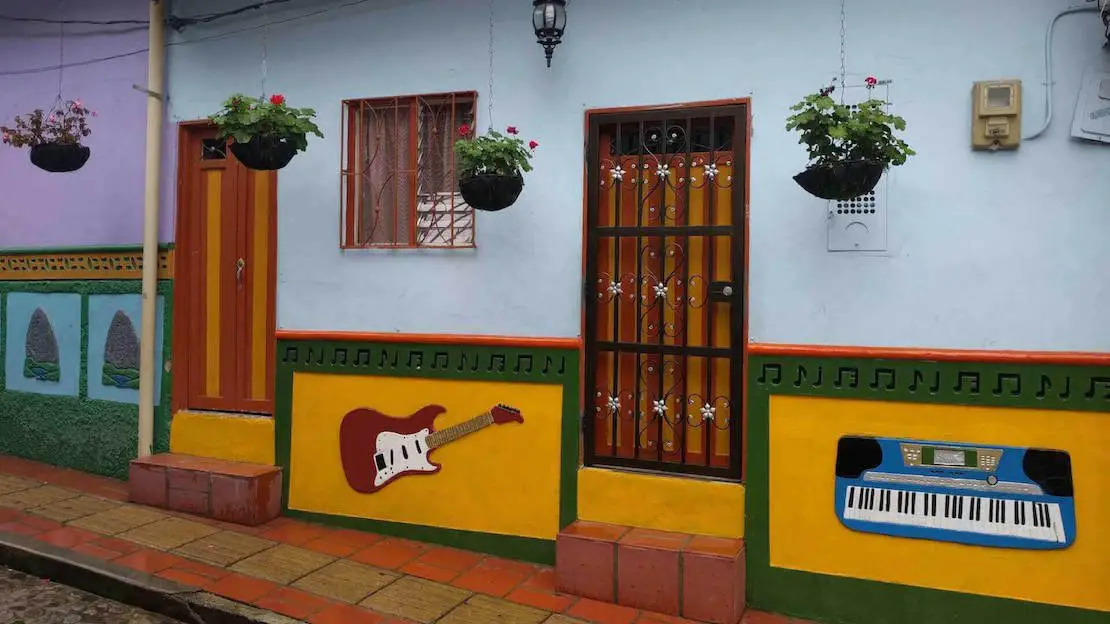
The colorful streets of Guatapé.
Cartagena
Cartagena, known in the colonial era as Cartagena de Indias, is a port city founded in 1533 in northern Colombia overlooking the Caribbean Sea. In 1984, the historic centre of Cartagena became a UNESCO-protected site.
What to do and see in Cartagena
The city’s main attraction is the walled historic center, among South America’s most beautiful. Other noteworthy sites include the fort (within walking distance) (Google Maps) that dominates the city and Playa Blanca (Google Maps). This lovely but very touristy beach is about an hour out of town (by bus).
How to get to Playa Blanca?
The round-trip shuttle service to Playa Blanca, which many facilities provide, costs 50000 COP. Alternatively, you can take a bus to Pascaballos at the intersection of Calle 30 and Carrera 17 (30 minutes, 1800 COP) and, from there, a moto taxi to Playa Blanca (20-30 minutes and 10000 COP approx.).
The graffiti tour is an enjoyable activity that takes half a day; the art pieces are numerous and, in many cases, remarkable.
Walking around town, you will be offered a boat tour to visit some islands, snorkel and Playa Blanca. Not having done it, I can’t give any feedback, but I imagine it could be a good way to spend the day.
In conclusion, budget travellers should know that Cartagena is Colombia’s most popular tourist destination. As a result, prices tend to be higher than in the rest of the country.
Where to sleep in Cartagena?
Hostal Casa Torres Centro Historico: clean, well located, breakfast included and air conditioning in the room (highly recommended in Cartagena), all at an excellent price compared to the competition.
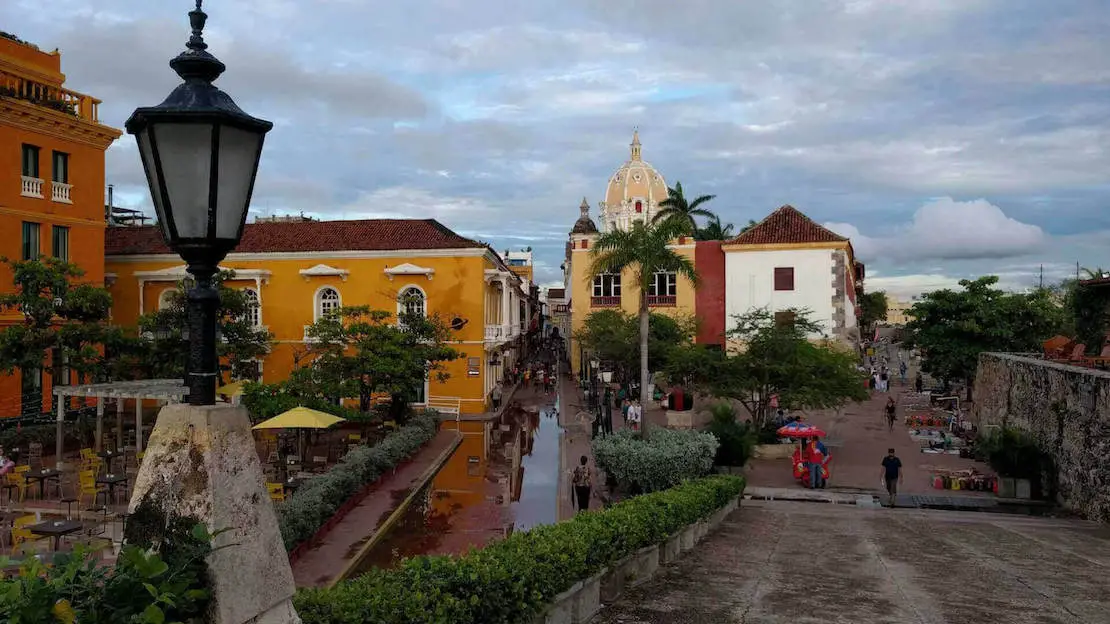
Cartagena historic center.
San Andres
San Andres is a Caribbean island that is only 15 km in length and 4 km in width. It is located about 700 km from the Colombian coast and only 200 km from Nicaragua, but it is part of Colombian territory. Here, you will find dreamy beaches and a sea so enchanting that it is called “Mar de siete colores” by the island’s inhabitants.
For those travelling on a budget, it is good to know that there is a tourist tax of 112500 COP and prices on the island are higher than in the rest of Colombia.
I refer to this article for information, having not been there personally.
The neighbouring island of Providencia, accessible by plane or an approximately two 1/2-hour boat ride, is less touristy and developed.
How to get to San Andres?
San Andres can be reached by air from all major Colombian cities; airlines that fly to San Andres are Avianca, LAN, Copa, VivaColombia, and Wingo. By booking in advance, it is possible to fly round trip for less than €100.
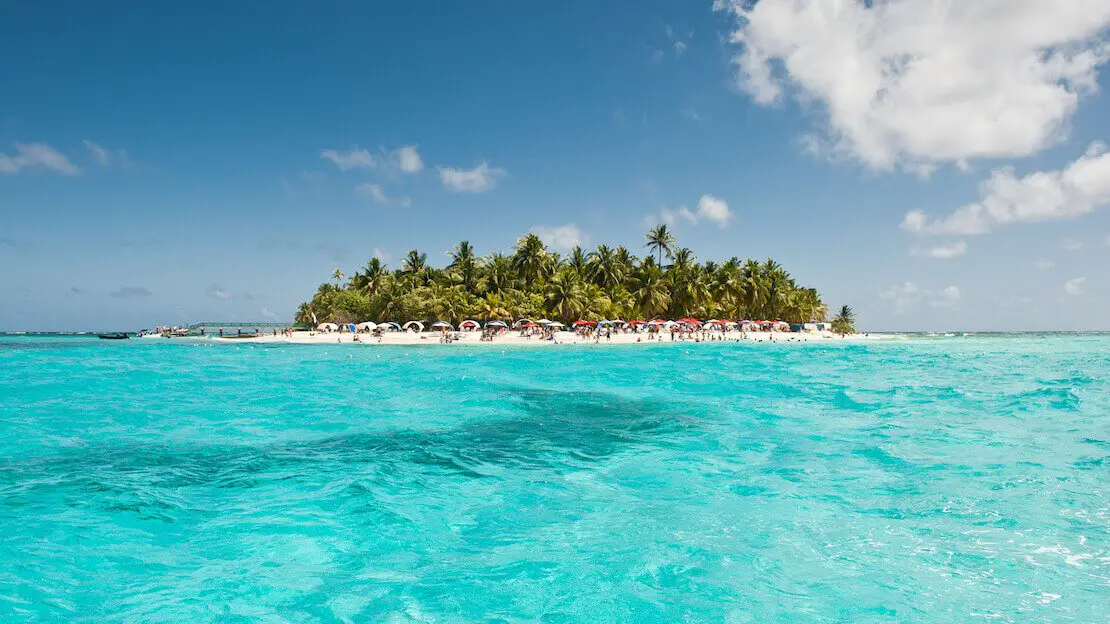
Johny Cay island, San Andres.
Barranquilla
This city should not be part of your tourist itinerary unless it is carnival time. The second most important carnival in Latin America after Rio de Janeiro takes place here, and in 2008, it was officially added to UNESCO’s list of Intangible World Heritage Sites.
The city does not have much to offer except the carnival, and I was repeatedly advised against visiting it. A reader who reiterated to me what I just said by saying, “city to avoid if you have no intention of going there for carnival,” however, pointed out some activities and places to visit in case you are in town for any reason.
1) Museo del Carnevale (Google Maps); 2) La Ventana del Mundo (Google Maps): a monument that overlooks the sea at the northernmost point of the Barranquilla waterfront, very popular and iconic for the city. 3)Malecon del Rio (Google Maps): nice walk along the riverfront; it is lovely if you go there at sunset. 4)Go to the typical restaurants to eat fish and carimagnoles galore! The latter are meatloaf and fried potato, delicious.
Santa Marta
Santa Marta is another port city located on the Caribbean coast, about a 4-hour bus ride from Cartagena; the not particularly pretty city does not have much to offer but is a good base for exploring many tourist attractions in this region.
Where to sleep in Santa Marta?
Dreamer’s Hostel is trendy. A pool, restaurant, billiards, kitchen, and bar make it an excellent choice to use as a base for exploring the surrounding area.
What to do and see in and around Santa Marta
Minca
Minca is a small village in the mountains just outside Santa Marta. The microclimate and atmosphere make it a great place to spend a few days relaxing while sipping a good coffee or visiting some of the waterfalls in the area.
Until recently, Casa Elemento, home to what they say are the most giant hammocks in the world, was a trendy place to stay and enjoy the incredible views. However, after changing management, the place seems to be in “disrepair.” it is still possible to visit in a day by taking one of the many moto taxis that leave from downtown Minca or simply walking for about 2 1/2 hours.
How do you go to Minca from Santa Marta?
Collectivos (shared cabs) leave from the intersection of Carrera 9 between Calle 11 and 12 for 8000 COP per person once complete. Many facilities can arrange door-to-door transfers for a group of people or you if you are willing to pay the total amount.
Where to sleep in Minca?
In addition to the Casa Elemento mentioned above, which would no longer seem to live up to its reputation, other recommended hostels are Casa del Pozo Azul and Dunarinka.
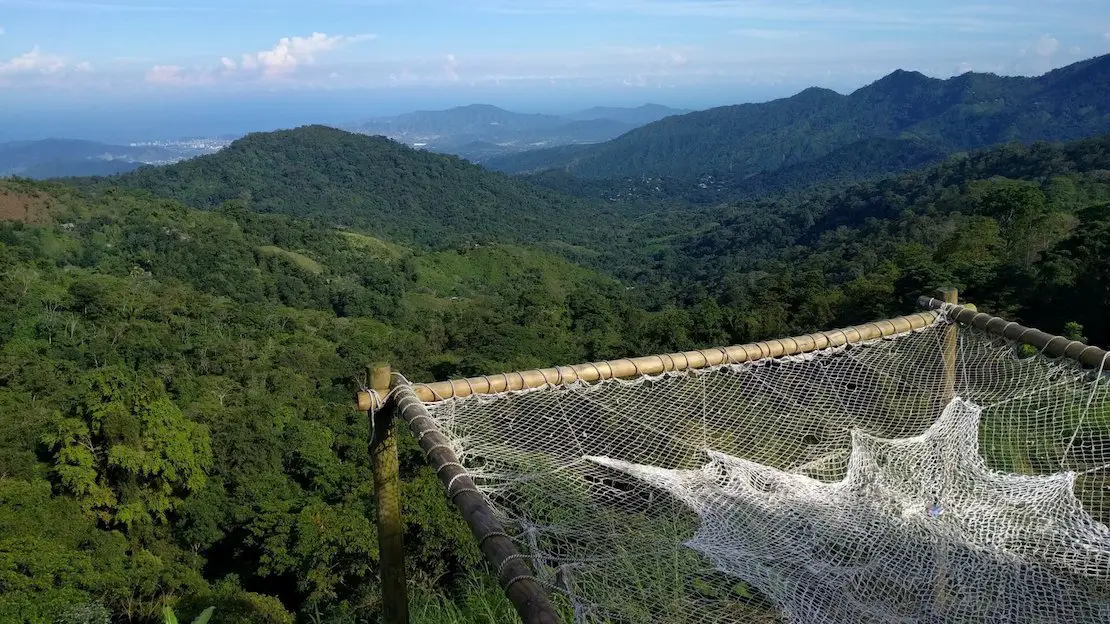
Casa Elemento Hostel, Minca.
Taganga
Taganga is a small town overlooking the sea that is not far from Santa Marta. It has been a favourite destination for many backpackers for years; it is a classic “party town.” Here, in addition to partying, relaxing and exploring the beaches in the surrounding area, you can go scuba diving and get your scuba certification; it is one of the cheapest places in the world to do so.
How do you go to Taganga from Santa Marta?
Many minibuses frequently depart from the Santa Marta bus terminal via downtown with destination Taganga (1600 COP); ask your hostel where the nearest stop is.
Palomino
Palomino, like Taganga, is a former fishing village that travellers have overrun in recent years; here, in addition to surfing when conditions permit and relaxing, it is possible to go tubing (riding down a river on inner tubes). The atmosphere here is much more relaxed than in Taganga.
How do you go to Palomino from Santa Marta?
Buses to Palomino leave near the market at the intersection of Calle 11 and Carrera 11 (10000 COP and approximately 1 hour and 45 minutes).
Where to sleep in Palomino?
Dreamer’s Hostel is undoubtedly the most popular (often fully booked, so it pays to book in advance); it is practically on the beach and has a pool, a bar, and a restaurant. Just like the one in Santa Marta, it is undoubtedly a good choice. Another hostel that I would recommend is the Bella Flor Hostel; it does not have a pool, and it is further from the beach, but it is incredibly cheap, breakfast is included, and the couple that runs it is just great.
Ciudad Perdida
Ciudad Perdida, literally the lost city, is the remains of a pre-Columbian city founded roughly 800 A.D. (about 650 years before Machu Picchu) nestled in the jungles of the Sierra Nevada Mountains that was only discovered in 1972.
The ruins can only be reached by an organised tour lasting 4-6 days of trekking through the jungle. However, the ruins are not as impressive as Machu Picchu; they are certainly noteworthy, and once you arrive at your destinations, there will be perhaps a hundred people versus the thousands who visit Machu Picchu daily.
Along the way, you sleep in basic facilities. The heat, humidity, and mud can make the “march” unpleasant, but the beautiful landscapes you pass through and the ruins themselves undoubtedly make the whole experience unforgettable.
To visit La Ciudad Perdida, it is mandatory to join a tour as it is all regulated by the government; When i did it, it only cost 700000 COP, ss of January 2024 the Ciudad Perdida Trek has increased to 2150000 COP. To be honest, I’m not sure it’s worth it anymore especially if you are traveling on a budget.

The Ciudad Perdida.
Tayrona National Park
Tayrona National Park is an excellent destination for trekking lovers, as well as beaches and nature. In addition to offering several jungle trails and the opportunity to relax on dreamy beaches, the park also provides hammocks and tents where you can spend the night in addition to the more expensive bungalows.
How do you visit Tyrona Park from Santa Marta?
Take the bus at the intersection of Calle 11 and Carrera 11 or anywhere along Av. El Libertador (in case you ask your lodging where the nearest bus stop is). The cost is 6000 COP, and the bus runs every half hour. Park entrance is 62000 COP. If you want to learn about it, I recommend you read this post.

Cabo San Juan, Tyrona National Park.
La Guajira
Here we go slightly off the classic tourist itinerary, but it is worth it. La Guajira is a department in northern Colombia. The capital, Riohacha, is easily accessible by bus from Santa Marta and its environs. Still, the region’s natural tourist attractions lie further north, where Cabo de la Vela and Punta Gallinas are.
Cabo de la Vela is a small fishing village where the excellent conditions for kitesurfing attract more and more tourists. You can, of course, take kite lessons or enjoy fresh lobster for a few euros and reach Punta Gallinas, the northernmost point in Latin America.
While getting to Cabo de la Vela by public transportation is easy, continuing to Punta Gallinas requires joining a tour. Punta Gallinas has only one option for food and lodging (Hospedaje Alexandra). The lighthouse and the dunes overlooking the sea are well-worth and truly striking sights when visiting this remote and wild place.
How to reach Cabo de la Vela and Punta Gallinas?
Whether you are leaving from Santa Marta, Palomino, Taganga or any other towns nearby, I recommend you head to Riohacha (practically all the buses that pass along the coastal road heading east go there) and stay at the Nueve Uno Hostel. Here you can get all the information you need to reach Cabo de la Vela by public transportation (recommended choice) while spending as little as possible or directing you to an organised tour.
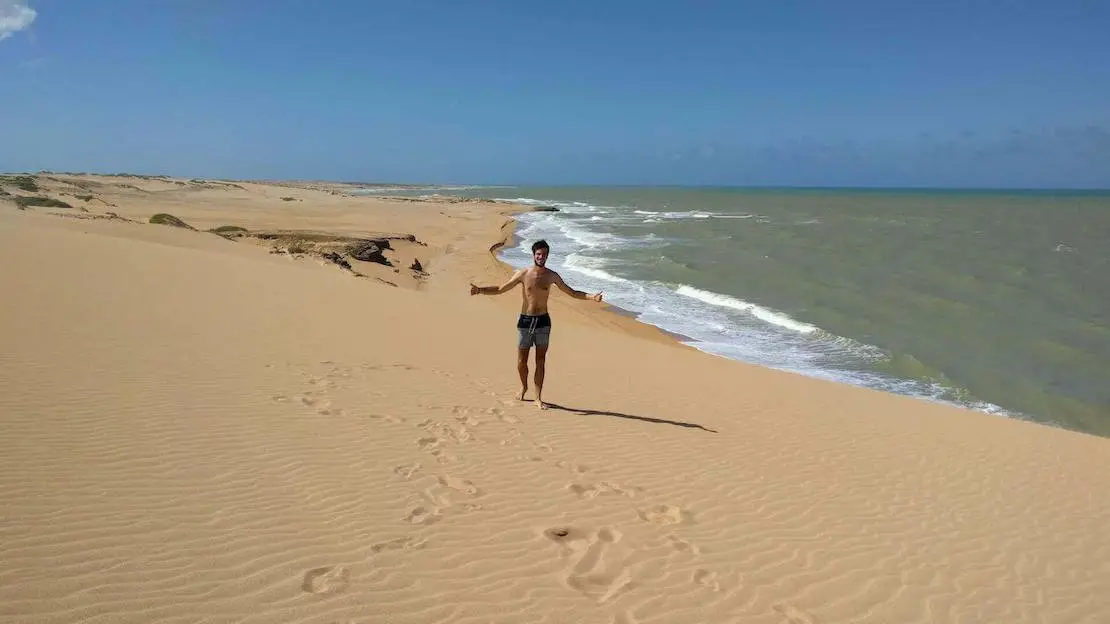
San Dunes around Punta Gallinas.
San Gil
San Gil, located about 7 hours north of Bogota by bus, is known as Colombia’s extreme sports capital. Here you can go whitewater rafting (rapids up to level 5!), paragliding (there are several options; I recommend the flight of about half an hour over Chicamocha Canyon, which is impressive and costs about 150000 COP, but there are other launches that are less expensive), mountain biking, canyoning and many other extreme activities.
If you decide to pass through San Gil, I recommend a day trip to Barichara; it is a lovely colonial village that is only 45 minutes by bus from San Gil (9200 COP round trip), and the cemetery is fascinating. From Barichara, you can take the Camino Real (All Trails) to the village of Guana; a German coloniser restored the route during the 19th century and is well-marked, so you don’t need a guide (it is also marked on maps.).
The trail starts at the intersection of Carrera 10 and Calle 4 (northwest of Barichara) and takes about 3 hours, during which you will have fantastic views of Chicamocha Canyon. Once in Guana, you can take the bus back to San Gil.
How to get to San Gil?
From Santa Marta, it is about 12 hours, 7000 COP.
From Bogota, it is about 7 hours and 35000 COP.
Where to sleep in San Gil?
THIS IS COLOMBIA HOSTEL is well-located, clean and cheap; the staff is amiable and helpful. Recommended.
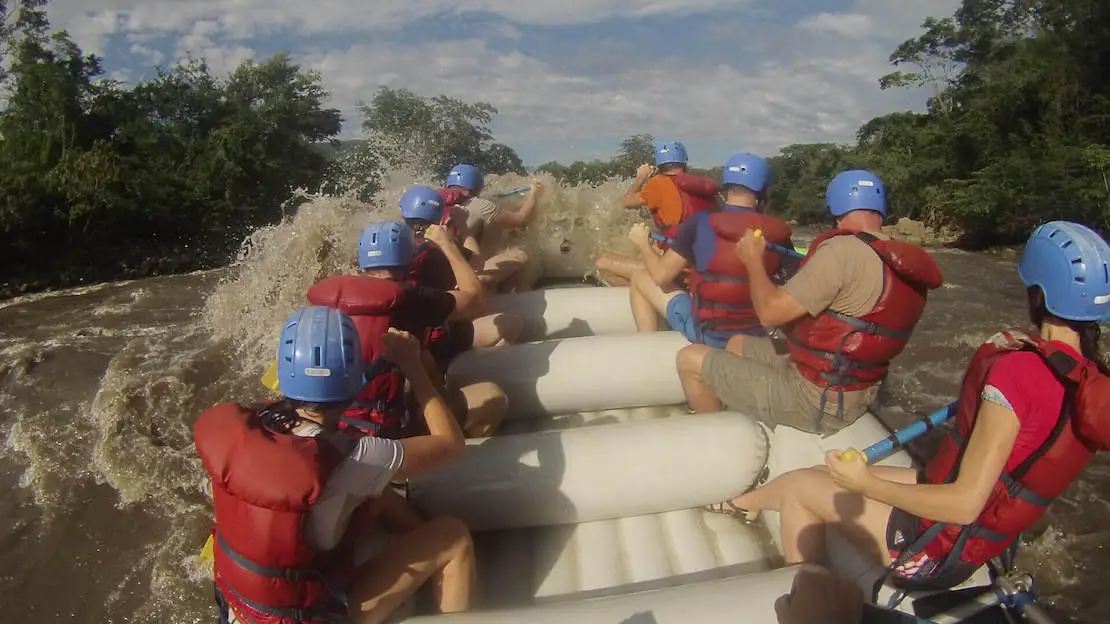
Rafting Rio Suarez, San Gill.
Villa de Leyva
Villa de Leyva is a colonial village that can be visited on foot, given its size, but other attractions can keep you busy for a couple of days. Having not been there personally, I refer you to an excellent article here.
How to reach Villa de Leyva?
Direct buses leave from the Portal del Norte Bus Terminal in Bogota (3 hours about 20000 COP). If you come from San Gil, you must first go through Tunja (about 4 hours).
Leticia
Leticia is a city located on the banks of the Amazon River that serves as a central hub for visiting the Amazon rainforest and is part of a larger settlement that includes the Brazilian city of Tabatinga. Essentially, it is a single city cut in half by the border between the two countries (one can cross from one side of the town to the other without having to go through immigration each time), while on the other side of the river is the city of Santa Rosa, which is part of Peru.
As already mentioned, the main reason for visiting the city is to see the Amazon rainforest and participate in all the tourist activities: cruises on the Amazon, hikes, tours, etc.
Not having personally visited Leticia, I refer to this excellent article.
How to reach Leticia?
It is possible to reach Letica by air from Bogota with Lan or Avanca; unfortunately, the low-cost airline VivaColombia recently stopped operating on this route.
It is also possible to reach Letica by boat from Manaus (Brazil) and Iquitos (Peru).
Prices (often negotiable) and trip duration are approximate. There are also faster but more expensive boats; food is included in both cases, but buying your hammock and cutlery and dishes to eat with is necessary. Below, you will see some examples. For more information, I suggest you visit the “get in” and “get out” sections of the destination at wikitravel.org.
Tabatinga -> Manaus 3-4 days 150-200 Reales
Manaus -> Tabatinga 7 days 300 Reales
Santa Rosa -> Iquitos 2-3 days $20-$25
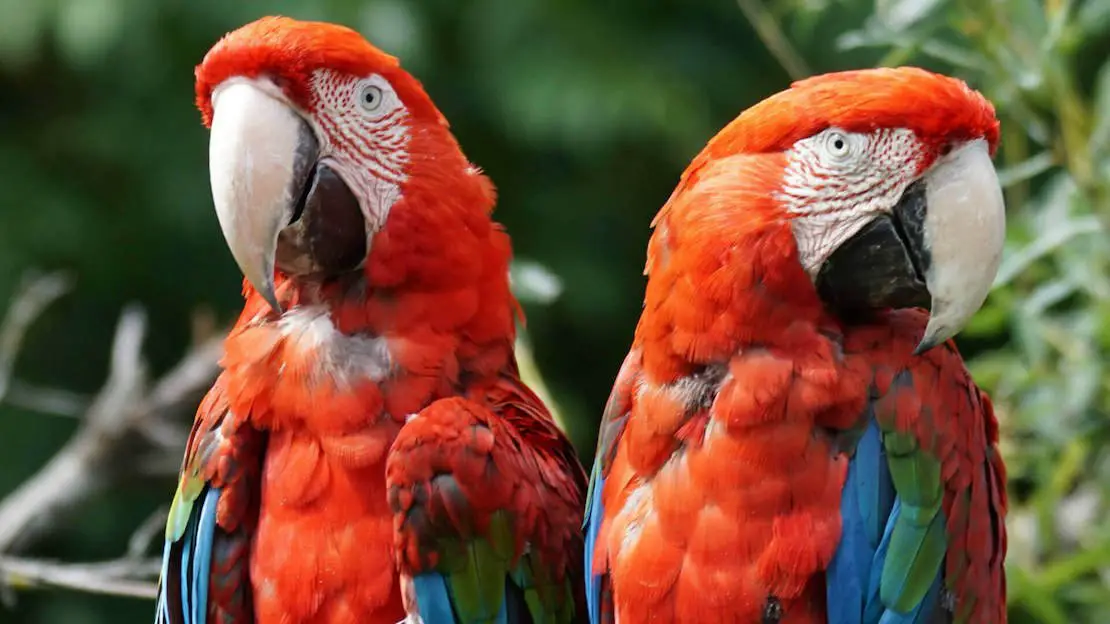
Tatacoa Desert
The Tatacoa Desert is the second driest area in Colombia after Gujarat. It is a short distance from Neiva, a remote place with few hotel options and no internet connection.
Here, the main attraction is the curious rock formations that form surreal labyrinths up to 20 meters deep.
Being a very remote and arid place, there is almost no light pollution or humidity in the air, thus making it an ideal place for stargazing.
How to reach the Tatacoa desert?
To get to the Desert, you must go through the city of Neiva from Bogota. It is about 6 hours and 30000 COP. Once in Neiva, you have to take a minibus to Villavieja, about 7km from the desert (6000 COP or 15000 COP to be taken directly to the desert).
A detailed article discussing the desert and the observatory can be found here.
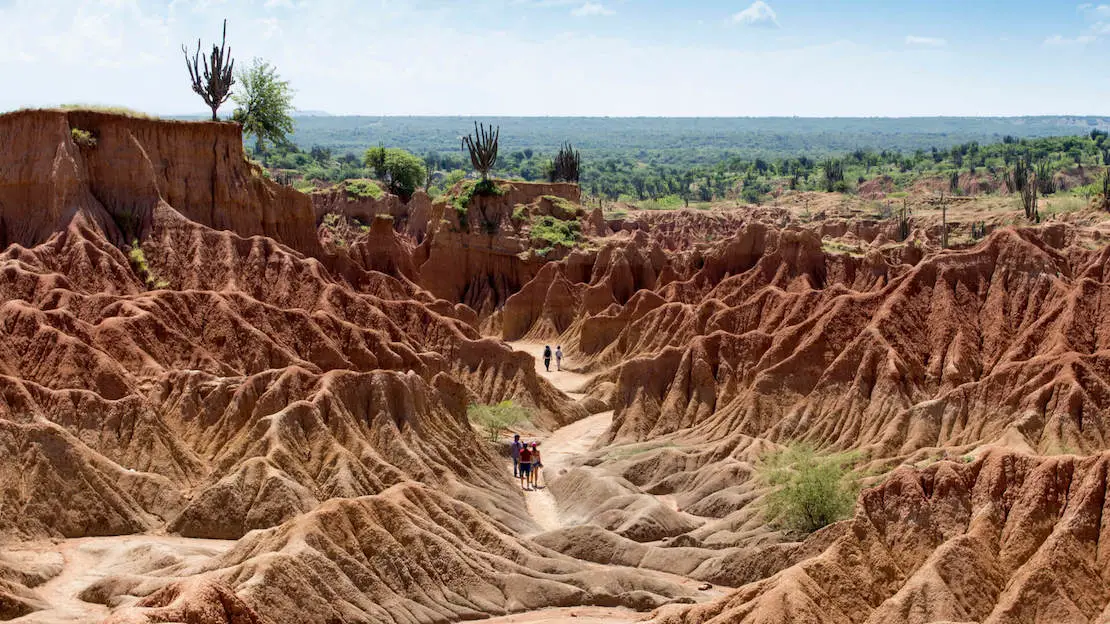
Tatacoa desert.
San Augustin
San Agustin is a small town in the department of Hulia famous for its pre-Columbian statues.
What to do and see in San Augustin
The archaeological park (Google Maps) is undoubtedly the place’s main attraction; there are many statues and a small museum. It is only 3 km from the town and can be reached by one of the frequent minibuses. Open daily from 8 a.m. to 4 p.m. except Tuesdays, 20000 COP.
El Estrecho del Río Magdalena (Google maps) is the narrowest point of the Rio Magdalena; here, the river is only 3 mt wide. The surrounding landscape, characterised by lush nature and the river’s energy, makes it an exciting visit.
How to reach El Estrecho del Río Magdalena?
Take one of the “camionetas” that leave from the intersection of Calle 5 and Carrera 14 bound for Oband.
Around San Agustin are other archaeological sites: La Pelota, El Purutal and the Obando Archaeological Park, in addition to the Salto de Bordones, which is the highest waterfall in Colombia.
Where to sleep in San Agustin?
Hotel casa de Nelly or Hostal Música y Arte.
How to reach San Agustin?
From Bogota, there is a direct night bus, which travels 69000 COP 9 hours approximately.
From Popoyan 5 hours 33000 COP.

The archaeological park, San Agustin.
Cali
Cali is Colombia’s second-largest city and universally recognised as the salsa capital of the world; somewhat like Medellin, it has been linked for years to drug trafficking and violence, but even here, great strides have been made in recent years.
What to do and see in Cali
Visit the San Antonio district (Google Maps). This is the oldest part of the city, and the colonial style dominates it. It is worth a walk. The whole area is filled with street performers and stalls during the weekend.
Cerro de Las Tres Cruces (Google Maps) is the hill that dominates the city with the three crosses at the top. I recommend going up early in the morning because it is boiling in Cali; once you get to the top, in addition to enjoying the excellent view of the city, it is exciting to see the dozens of local people working out in the open air gym. If possible, it is advisable to climb during the weekend when there are a lot more people (and police) on the various trails leading to the top since there have been robberies in the past.
Parque Simon Bolivar (Google Maps) is a park, and every night, it becomes home to numerous stalls selling extremely cheap street food, light games and lots of people strolling around.
Dancing Salsa: As mentioned above, Cali is world-famous for Salsa. You can find people dancing in the streets, impromptu stages, and nightclubs in every city corner.
How to reach Cali?
From Bogota, it is 10 to 12 hours and about 60000 COP.
From Armenia (coffee region), it is only 3 hours and about 25000 COP.
Where to sleep in Cali?
La Palmera Hostel is new, well-located, and fairly priced, with breakfast included.

Parque Simon Bolivar, Cali.
Popayan
Popayan is a beautiful colonial city known as the “white city,” it was a mighty city during the colonial period. Because of this, there are many noteworthy buildings: Iglesia de San Francisco, Iglesia La Ermita, Iglesia de Belen, and Puente del Humilladero.
I have not been there personally because I prefer to go directly to Ecuador, so for more information, I refer you to this article.
How to reach Popayan?
From Cali, it is only 2 and 1/2 hours and about 15000 COP. From Pasto, it is about 6 hours and 25000 COP, while from Ipiales (border with Ecuador), it is about 8 hours.
Ipiales
Ipiales is a frontier town and a mandatory stop if you are headed to Ecuador; if you have time, it is worth visiting the Santuario de Las Lajas (Google Maps), a Gothic-style church that is genuinely striking for its architecture and setting.
How to reach the Santuario de Las Lajas?
Take a minibus from the Ipiales bus station, which takes 15 minutes and is about 2200 COP.
Minibuses also leave from the bus station in Ipiales for the border with Ecuador, 1700 COP and 10 minutes or so. Here, you find plenty of people willing to exchange your pesos for dollars (the exchange rate is excellent and bargainable); once you pass both immigration, you can take a minivan to Tulcán and, from there, a bus to Quito or whatever your destination is in Ecuador ($0.75 or 2000 COP).
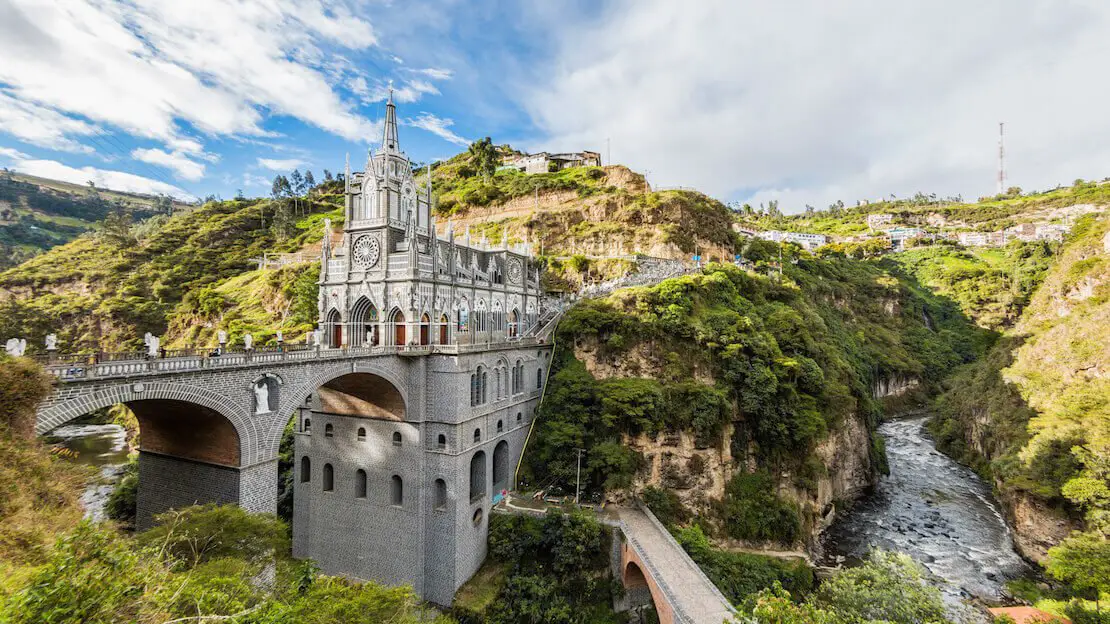
Santuario de Las Lajas, Ipiales.
If you found this article helpful, please consider purchasing your travel insurance through one of the links on this site, doing so supports my work at no additional cost to you. For EU & UK Residents, i recommend True Traveller. For everyone else i recommend HeyMondo (5% discount). Thanks!
Suggested itineraries in Colombia
Now that you’ve read about “all” the possible destinations, it’s time to think about a two-week itinerary that doesn’t require crazy travel and gives you a chance to savour the best of what this fantastic country offers with a 15-day itinerary.I recommend constructing an itinerary based on your interests/activities; in any case, if you imagine that your round-trip flight will be over Bogota, I advise focusing on the northwest of the country.
2-Week Itinerary in Colombia
Bogota (1 night)
Use the day to recover from the trip and explore Candelaria, perhaps by joining the free walking tour, if possible, go up to Monserrate. I recommend taking an overnight bus to save time and money.
Coffee region (2 nights)
Although I prefer Filandia, I recommend visiting Salento to maximise time and spend a whole day visiting the Cocora Valley, which I consider unmissable, and the other day to visit a few fincas or participate in a coffee tour. Again, it is possible to travel at night.
Medellin (2 nights)
I strongly recommend joining the free walking tour, as the rest depends greatly on personal interests. Find some interesting insights in the Medellin section.
Cartagena (2 nights)
You can take an overnight bus, but a flight with VivaColombia can be cheaper, will save you a lot of time, and will ensure a good night’s sleep. Visit the historic centre. From Cartagena to Santa Marta is only 3-4 hours by bus.
Santa Marta (3 nights)
Again, it depends greatly on your interests: Tyrona Park, a few days of relaxation in Palomino or Minca, diving, partying in Taganga, squeezing in somewhere else, and visiting La Ciudad Perdida are all excellent options. From here, I recommend heading down to San Gil by overnight bus.
San Gil and Villa de Leyva (3 nights)
I recommend San Gil over Villa de Leyva because it has much more to offer regarding activities. If you want to visit a cute colonial village, you can always visit Barichara during the day. In any case, you could always spend a night in Villa de Leyva before returning to Bogota.
Bogota (1 night)
Here, it depends a lot on your flight; if timing allows, you could go directly to the airport from Villa de Leyva or San Gil without spending the night in Bogota. It’s risky in case something goes wrong, but it’s possible.
3-Week Itinerary in Colombia
I advise using the two-week itinerary and adding a destination between San Andrés, Leticia and La Guajara according to your preferences. Alternatively, you could follow the two-week itinerary moving more slowly.
4-Week Itinerary in Colombia
One month should be enough time to visit the vast majority of Colombia’s leading tourist destinations and complete the entire “circuit”, which I believe is the most efficient and economical way to travel.
How to get around Colombia
Let’s start by saying that public transportation is highly efficient and cheap; buses, camionetas, and collectivos go everywhere because so many people do not have their vehicles and rely on public transportation. In 6 weeks, I think I took a cab three times. Whenever possible, I recommend travelling at night for long trips to save time and money (no need to pay for the night in the hostel/hotel). Many companies that cover long routes offer excellent service, the buses are new and comfortable, and some even have Wi-Fi on board – Bolivarian, Expreso Brasilia, and Copetran, to name a few. Two pieces of advice regarding night buses:
- Bring a sweatshirt on board because, for some strange reason, all the night buses I took had air conditioning at sidereal temperatures.
- The ticket price is often negotiable, especially for long routes; try it.
Some companies allow you to buy tickets online or on busbud. I sincerely do not recommend it; ticket prices, if purchased directly at the terminal, are lower, and if you are one of those people who want everything planned down to the last detail or are simply afraid of buses running out of seats, then buy your ticket for the next leg whenever you arrive at your destination at the terminal.
Domestic flights in Colombia
As for domestic flights, I recommend you look at Wingo. Viva Colombia used to be a good option but has gone bankrupt.
Taxi in Colombia
In some cities, it is possible to use Uber (cheaper than regular cabs); if you opt for cabs instead, remember that in some cities, cabs are used, and in others, it is a good idea to agree on the price before you get in, perhaps by asking someone local what the correct cost is for a particular route.

The camioneta for the stretch between Uribia and Cabo de La Vela.
Backpacking Colombia: costs
How much does a backpacking trip to Colombia cost?
Cost of transportation in Colombia
As mentioned, getting around Colombia is relatively inexpensive if you use public transportation. For many destinations, you will find the cost of bus tickets (prices are approximate and, in some cases, may be out of date).
Cost of accommodation in Colombia
A bed in a reasonable hostel costs, on average, between 20000 and 30000 COP, depending on the city and time of year.
Cheap hotels start at 40000 COP, while for something more luxurious, expect to pay at least 80000 COP.
For those looking to travel on the cheap but not willing to sleep in dorms, I still recommend sleeping in hostels in a private room. Airbnb is undoubtedly another option.
Cost of food in Colombia
A menu del dìa, literally “menu of the day”, readily available for lunch, costs on average between 7000 and 10000 COP, including soft drinks; in the evening, street food is a perfect economical option. Meanwhile, a meal in a medium-high restaurant starts at about 40000 COP. Plenty of hostels provide a kitchen and many facilities, including breakfast. Exito is the largest but not the cheapest supermarket chain. The cheapest are: D1, Justo&Bueno and Ara where sometimes you can find the same products as Exito for 50% less. A local beer in a bar normally costs between 2500 and 3000 COP.
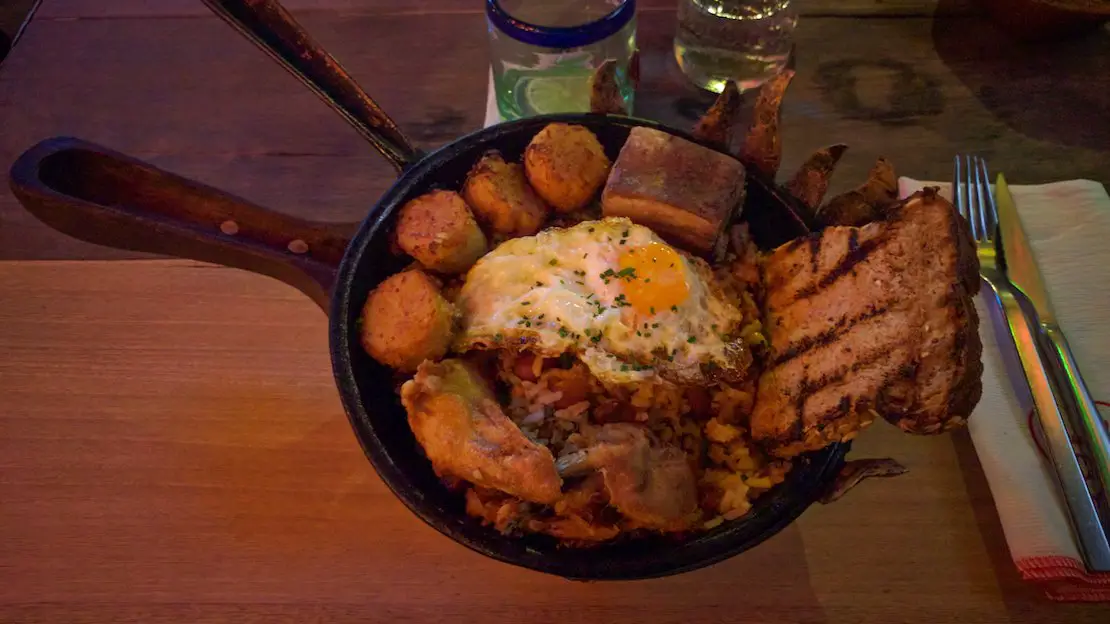
Typical colombian dish.
Cost of activities in Colombia
Many proposed tours can be done independently using planning and public transportation. Of all the destinations and activities mentioned above, the only ones requiring tour participation are La Ciudad Perdida, Punta Gallinas, a hypothetical Amazon rainforest tour in Leticia, coffee tours, and extreme sports in San Gil. Entrances to parks and museums are not very expensive.
In conclusion, as a backpacker you should not have much trouble staying within the budget of around 30/35€ per day.
Backpacking Colombia: safety and security
Is Colombia dangerous? As repeated several times before, Colombia is not a particularly dangerous country, or at least it is no more hazardous than other Central and South American countries. Of course, common sense should be used, and specific neighbourhoods should be avoided, especially in large cities. For tips and tricks on how to travel safely, I am referring you to this article.
Do you have any questions? Updated information? Feel free to leave a comment or message me on Instagram!
If you found this article helpful, please consider purchasing your travel insurance through one of the links on this site, doing so supports my work at no additional cost to you. For EU & UK Residents, i recommend True Traveller. For everyone else i recommend HeyMondo (5% discount). Thanks!
For donations/pizzas and virtual beers 🙂
Did you like the post? Pin it!
